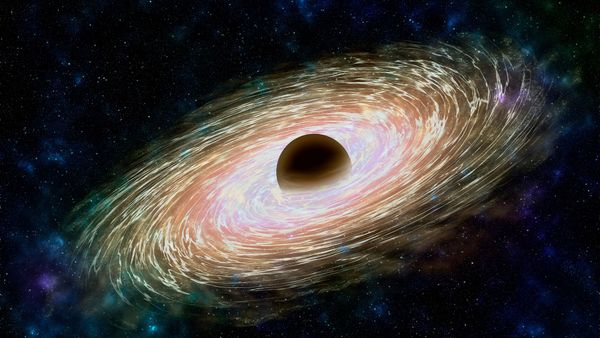New Horizon Prize in Physics awarded to scientists chasing mysterious black hole photon spheres
Alexandru Lupsasca and Michael Johnson won the physics prize for their work on photon spheres — weird rings of light around black holes that may reveal a theory of quantum gravity.

Two scientists have won a $100,000 prize for describing both the structure and a way to detect mysterious black hole photon spheres. These enigmatic structures form at the edges of black holes, and could reveal the underlying physics that govern the most extreme objects in the cosmos.
Alexandru Lupsasca, of Vanderbilt University, and Michael Johnson, of Harvard University, won the New Horizon Prize in Physics "for elucidating the sub-structure and universal characteristics of black hole photon rings, and their proposed detection by next-generation interferometric experiments."
The New Horizons award is given each year to early career researchers by the Breakthrough Prize Foundation, and the prize money is donated by tech billionaires Sergey Brin, Priscilla Chan and Mark Zuckerberg, Yuri and Julia Milner, and Anne Wojcicki. A second prize was also awarded this year to Mikhail Ivanov, of MIT, Oliver Philcox, of Columbia University and the Simons Foundation, and Marko Simonović, of the University of Florence for their work on the universe's 'cosmological collider'.
When photons stream toward a black hole, most are either bent away or (if they cross its event horizon) engulfed permanently in the dark abyss. Yet some rare light particles avoid this fate — instead they surf the cosmic monster's gaping mouth in a series of tight orbits and, if the black hole is spinning, steal some of its rotational energy to miraculously spring free.
Related: Supermassive black holes eat more quickly than expected, 3D simulations suggest
Detecting these photons for the first time would give physicists unprecedented insight into the most extreme objects in our universe, as well as how the known laws of physics break down in the presence of their infinite gravitational pulls.
"Gravity is the big mystery. To date we don't know how to combine Einstein's theory of general relativity, which is the relativistic picture of gravity as the bending of space-time, with quantum mechanics," the theory of the very small, Alexandru Lupsasca, who used relativity to devise what the rings should look like and find the parameters that describe them, told Live Science.
Breaking space news, the latest updates on rocket launches, skywatching events and more!
"The problem is that gravity is very weak — it's the weakest of all forces," Lupsasca said. "So to have a chance of understanding quantum gravity, we have to look where gravity is strongest. And nowhere is gravity stronger than around a black hole."
Searching for a cosmic laundromat
Supermassive black holes are enormous, measuring roughly the width of the solar system, so it can take a photon around six days travelling at the speed of light to make an orbit. At the end of these six days, photons can either perform a U-turn to make another orbit, or fly into or away from the black hole. The photons that slip a black hole's gravity emerge in the form of an ultrathin halo around the pure black chasm: a photon sphere.
Photon spheres can be broken down into even smaller rings, with the light that went in last nesting in near-infinite bands inside the light that went in first. Peeling back these layers would reveal a string of snapshots displaying every angle of the surrounding universe, beginning with the recent past and running all the way back to the scant remaining glimmers of light captured eons ago by the black hole.
"It's like a laundromat, it takes light from every angle, lets it tumble and shoots it off in every direction," Lupsasca said. At any given time, only some photons can fit: "there's always more photons coming in, but there's always some leaking out."
After making theoretical predictions of what the rings should look like, the pair and their colleagues set about devising ways to measure the halos. Johnson realized that the Event Horizon Telescope (the EHT, which he and other researchers had used to capture the first-ever image of a black hole) was perfect for this task, if only the photon sphere could be distinguished from the fuzzy band of other light streaming from the black hole.
To achieve this, Johnson reasoned, researchers would only need to place the EHT into an array with one more telescope to distinguish the first band of the photon sphere.
"The miracle is that — and this is unlike anything we've ever studied in astronomy — that you can add one orbiter that's enough to study the photon ring," Johnson told Live Science. "That was just a complete shock."
Lupsasca and Johnson are working on a pitch to have NASA launch a satellite carrying the extra telescope. If successful, they could obtain the very first image of the outer band of a photon sphere within 10 to 15 years. Doing so would enable them not only to judge the size of a black hole's event horizon and its spin but also, once they have measured a second band, to probe some of the most radical theories in physics.
"This photon ring comes from as close as you can see to the visible edge of the observable universe," Lupsasca said. "If that's not enough to get you excited, I don't know what gets you out of bed."

Ben Turner is a U.K. based staff writer at Live Science. He covers physics and astronomy, among other topics like weird animals and climate change. He graduated from University College London with a degree in particle physics before training as a journalist. When he's not writing, Ben enjoys reading literature, playing the guitar and embarrassing himself with chess.

